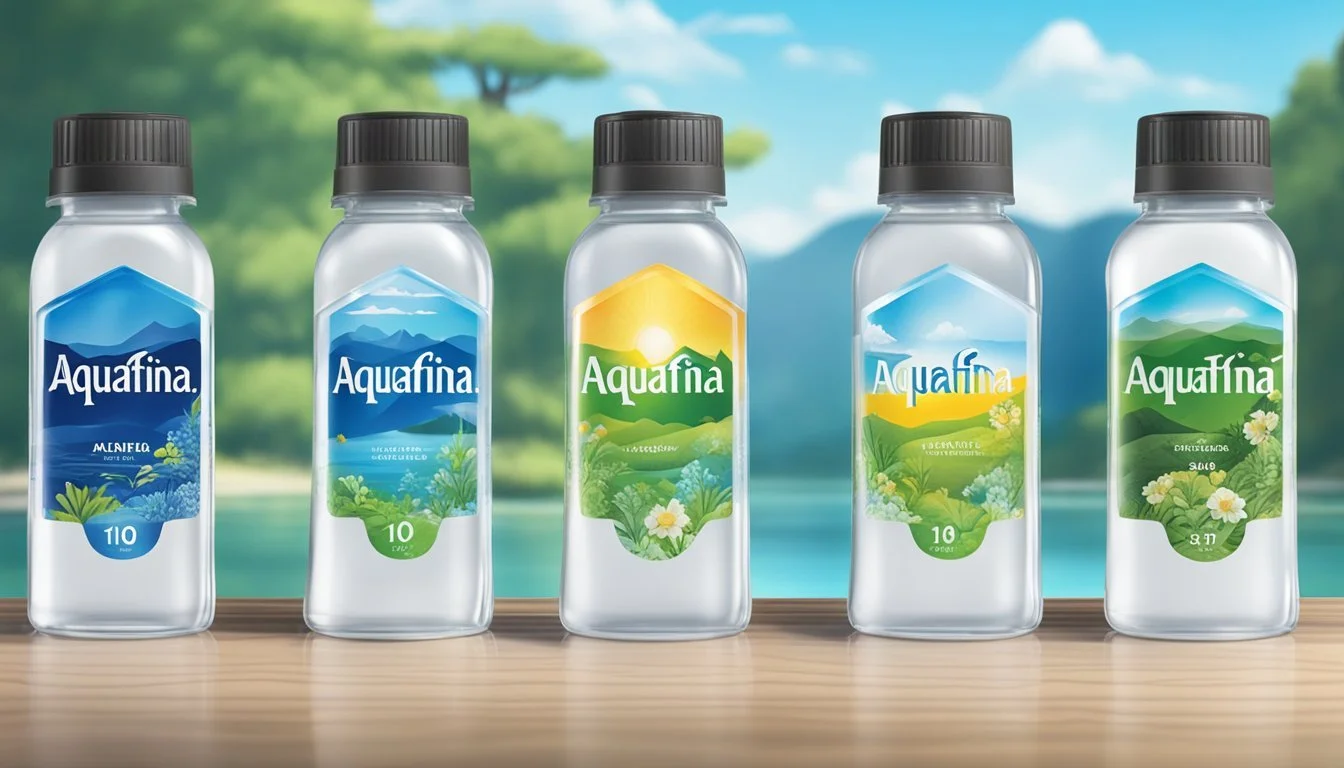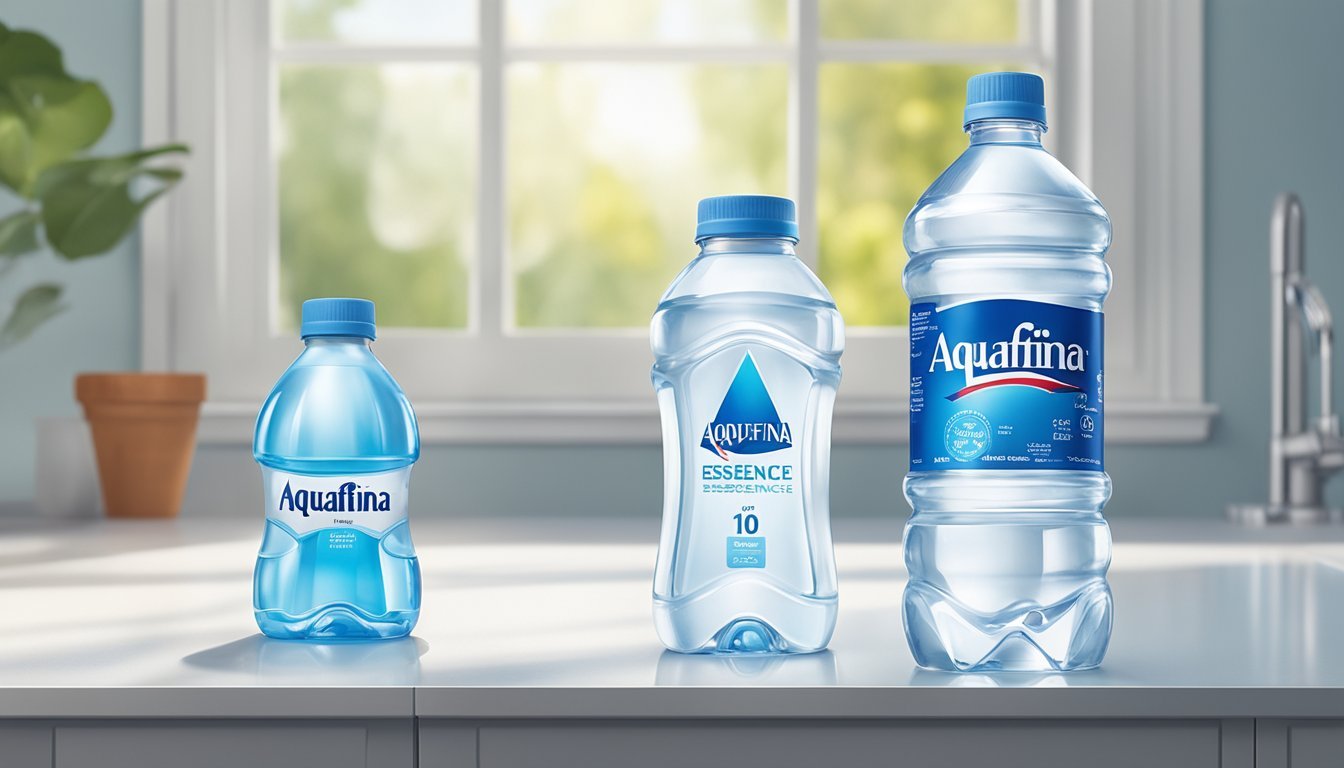Aquafina vs. Essence pH10
Ultimate Bottled Water Comparison
Choosing the right bottled water can be challenging, especially with so many options available. Aquafina and Essence pH10 are two popular choices that frequently come up in discussions. For those prioritizing pH balance, Essence pH10 stands out due to its alkaline properties with a pH level of 10. This can be especially appealing for individuals looking to neutralize acidity in the body.
Aquafina, on the other hand, offers a crisp and refreshing taste through its rigorous purification process. It is a reliable choice for those who prefer water with a neutral to slightly acidic pH level, typically around 6.5 to 7.5. The purification ensures that Aquafina remains free from impurities, making it a safe everyday option.
Both waters have distinct advantages depending on the consumer's needs. While Essence pH10 caters more to those interested in the potential health benefits of alkaline water, Aquafina provides a consistently clean and refreshing experience.
Overview of Aquafina and Essence pH10
Aquafina is a purified bottled water produced by PepsiCo. The brand uses a specific purification process that includes reverse osmosis, which helps to remove impurities and minerals. Aquafina water generally has a pH level around 5.5 to 7, making it slightly acidic.
Essence pH10 is a high-alkaline bottled water known for its advanced ionization and filtration processes. It typically boasts a pH level of 9 to 10, which is considered alkaline. This high pH level may appeal to those looking for water that can potentially help balance the body’s acidity.
Brand Source pH Level Purification Process Aquafina Municipal 5.5 - 7 Reverse osmosis, ozonization, UV light Essence pH10 Natural groundwater 9 - 10 Ionization, microfiltration, UV light
Aquafina emphasizes providing clean and crisp hydration, achieved through a Hydro-7 purification system. This involves seven steps to ensure the water is thoroughly purified.
Essentia, known for its high pH water, incorporates additional filtration and ionization techniques. These processes not only purify the water but also enhance its alkalinity, which is a unique feature compared to standard bottled water options.
Both brands cater to different preferences: Aquafina for its widespread availability and established purification methods, and Essence pH10 for its high pH and advanced filtration. The choice between them often comes down to personal taste and health philosophy.
Determinants of Water Quality
Understanding the key determinants of water quality provides insight into which bottled water choices may be better for consumption. This analysis covers purity, contaminants, filtration processes, sources, pH levels, alkalinity, mineral content, and electrolytes.
Purity and Contaminants
The purity of bottled water is essential for safety and taste. Pure water should be free from contaminants like bacteria, heavy metals, and PFAS chemicals.
Aquafina undergoes a proprietary purification process known as HydRO-7, which removes impurities. Essence pH10 also claims high purity through rigorous processes, eliminating contaminants to ensure clean drinking water. Consumers should be wary of bottled water with known contaminants, which can pose health risks.
Filtration Process and Source
The filtration process and water source significantly impact the quality of bottled water.
Aquafina sources its water from municipal supplies and then treats it with a seven-step reverse osmosis treatment to remove impurities. This method is effective in eliminating most contaminants and improving taste. Essence pH10 prides itself on using natural spring sources and employs distillation and additional filtration steps to ensure purity. The source determines the initial quality of the water, and the filtration process ensures it remains safe and palatable.
pH Levels and Alkalinity
The pH level of water determines its acidity or alkalinity, measured on a scale from 0 to 14.
Aquafina has a pH of 5.95, making it slightly acidic. In contrast, Essence pH10, designed to be alkaline, often has a pH closer to 10. The ideal pH level for drinking water is around neutral (pH 7), though some prefer alkaline water for its purported health benefits. pH levels can affect taste and may impact health, especially for those with specific dietary needs.
Mineral Content and Electrolytes
Bottled water often contains minerals and electrolytes, which can enhance hydration and provide essential nutrients.
Aquafina's mineral content is minimal due to its extensive purification process, which removes most minerals. Essence pH10 typically includes added minerals and electrolytes like calcium, magnesium, and potassium, aiming to improve taste and hydration benefits. While minerals and electrolytes can be beneficial, some prefer the pure taste of demineralized water. The presence or absence of these elements can influence a consumer’s preference and the perceived quality of the water.
Health Benefits and Hydration
Aquafina and Essence pH10 offer distinct hydration benefits influenced by their composition and mineral content. Both aim to impact body hydration and overall health differently.
Optimal Hydration and Essential Minerals
Aquafina is purified through a rigorous 7-step HydRO-7 filtration process. This thorough filtration removes impurities, resulting in clean, crisp water without added minerals. While this ensures purity, the lack of minerals like magnesium and calcium means it doesn't provide additional essential nutrients.
Essence pH10, in contrast, is alkaline water with a higher pH. It contains added minerals, which some believe contribute to superior hydration. Minerals like magnesium and calcium are essential for bodily functions, acting as electrolytes that support hydration at a cellular level. These added minerals might offer slight benefits for those looking to increase their intake of these nutrients.
While Aquafina focuses on purity, Essence pH10 emphasizes the mineral content. Each option caters to different hydration preferences and needs.
Impact on Body's pH and Health
Essence pH10's higher pH claims to help balance the body's acidity. Proponents suggest that alkaline water might neutralize acid in the bloodstream, potentially leading to better health outcomes. This includes improved hydration levels and possibly reduced acid reflux symptoms. However, significant scientific evidence to support these claims is limited.
Aquafina, with its neutral pH, does not impact body acidity. It's designed for general hydration without altering the body's pH balance. This makes it a suitable choice for those who prefer water without any additional health claims or alterations in their body's pH.
In essence, the health benefits each water offers are tailored to specific needs—whether seeking added minerals and potential pH benefits with Essence pH10 or pure, straightforward hydration with Aquafina.
Taste Experience and Preferences
When evaluating Aquafina and Essentia, it's important to consider the flavor profile and the distinct sensations each water provides. Both brands offer a different experience based on their purification processes and mineral content.
Flavor Profile and Water Taste
Aquafina goes through a rigorous purification process, resulting in a very neutral taste. This is often described as crisp and clean, with no discernible aftertaste. This neutrality makes it a popular choice for those seeking a straightforward, refreshing water experience.
Essentia, on the other hand, boasts a higher pH level due to its ionization process. This gives it a slightly different flavor profile, often perceived as smoother and more alkaline. Some consumers find this taste more enjoyable, noting a subtle mineral presence that adds to the overall hydration experience.
Clean vs. Smooth Taste
The clean taste of Aquafina comes from its thorough purification, which removes most impurities and provides a highly filtered water. This results in a crisp and refreshing mouthfeel, favored by those who prefer their water to taste as neutral as possible.
Essentia’s smooth taste is attributed to its ionization and higher pH levels. The water feels almost silky on the palate, which some drinkers find more pleasant. The added electrolytes contribute to this smoothness, making it a preferred choice for those who enjoy a bit more character in their water.
Environmental Impact and Sustainability
Aquafina and Essence pH10 bottled waters impact the environment in distinct ways through their packaging practices and water source conservation efforts. Understanding these factors helps consumers make better choices regarding sustainability.
Packaging and BPA Concerns
The packaging of bottled water is a significant environmental issue. Both Aquafina and Essence pH10 use plastic bottles, contributing to the large amounts of plastic waste.
Aquafina bottles are made from PET plastic, which is recyclable but often not recycled, leading to pollution.
Essence pH10 aims to use BPA-free plastics, reducing concerns about chemical leaching. BPA (Bisphenol A) is a chemical that can seep into beverages from plastic containers, posing health risks.
Efforts to minimize packaging waste include using lightweight bottles and promoting recycling initiatives. This can reduce the overall carbon footprint of bottled water production.
Water Source Conservation
Water source conservation is crucial for sustainable bottled water production. Aquafina sources its water from municipal supplies, which undergoes a rigorous purification process called HydRO-7. This method ensures the water is safe but relies on already strained public water systems.
Essence pH10, in contrast, sources from natural springs. Protecting these sources involves maintaining the natural ecosystem and preventing over-extraction.
Both companies need to ensure their water extraction methods do not deplete local water tables or harm the surrounding environment. Implementing sustainable water management practices helps balance consumer demand with ecological preservation.
Comparison of Bottled Water Brands
In comparing bottled water brands, one should consider market alternatives and competitors, as well as price and convenience. These aspects allow consumers to make informed decisions about which water suits their needs best.
Market Alternatives and Competitors
There are numerous bottled water brands available, each with unique characteristics and target consumers. Aquafina, sourced from municipal supplies and treated through the HydRO-7 process, has a slightly acidic pH of 5.95. Essence pH10 offers alkaline water with a pH of 10, targeting those seeking higher alkalinity.
Dasani, another municipal-sourced brand, has a similar profile to Aquafina. Fiji and Voss are known for their pristine sources; Fiji boasts natural artesian water, while Voss provides still and sparkling options.
Smartwater appeals to those desiring vapor-distilled water, while Poland Spring, Zephyrhills, and Deer Park offer various natural spring waters. For premium options, Acqua Panna and Icelandic Glacial deliver mountain and glacier-sourced waters, respectively.
Eternal, Core Hydration, and LIFEWTR emphasize pH balance and enhanced hydration. Budget-friendly alternatives like Pure Life and Nestle Pure Life remain popular.
Price and Convenience
When evaluating bottled water, price and convenience are critical. Aquafina and Dasani often lead in affordability and availability, frequently found in supermarkets and convenience stores.
Essence pH10, a specialty alkaline water, commands a higher price due to its enhanced pH features. Fiji and Voss fall in the premium price range, partly due to their exotic sourcing and high-end packaging.
Bulk purchasing options from brands like Pure Life and Nestle Pure Life appeal to budget-conscious consumers, while convenient, on-the-go packaging from San Pellegrino and Just Water caters to those seeking quick hydration.
Brands like Ethos Water and Boxed Water often attract eco-conscious buyers, offering sustainable packaging options. Additionally, Smartwater and Eternal are marketed for their health benefits, justified by a slightly higher price point.
Convenience and price play significant roles, with options to suit various preferences and budgets. By assessing these factors, consumers can choose a water brand that aligns with their lifestyle and hydration needs.
Safety Standards and Regulations
Both Aquafina and Essence pH10 comply with FDA regulations, ensuring their bottled water meets safety standards. The FDA sets strict guidelines for bottled water, including limits on contaminants and requirements for testing and labeling.
Aquafina utilizes a seven-step HydRO-7 filtration process, which removes impurities and maintains water purity. This method adheres to the FDA's stringent safety protocols.
Essence pH10 undergoes a rigorous purification process as well. This includes multiple stages of filtration to eliminate harmful substances and enhance water quality, ensuring compliance with regulatory standards.
Both brands emphasize quality control and regularly test their products to meet the FDA’s requirements.
FDA Regulations:
Contaminant limits
Regular testing
Effective labeling
Following these guidelines helps both brands ensure their water is safe and reliable for consumers. Frequent testing and adherence to regulations demonstrate a commitment to providing high-quality products.






